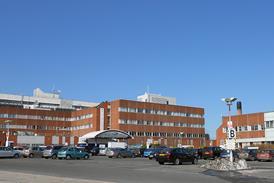Essential insight into England’s biggest health economy, by Ben Clover.
There will probably need to be a statue put up, at least, for London’s NHS staff when this is all over.
The system, always busy, is in what may be the toughest week in its history — although that could change, for the worse, by next week.
On top of the scramble for personal protective equipment and ventilators, the centre and the London regional team have been working to ramp up the capital’s ITU capacity by a factor of almost four.
Where are these?
In London, the capacity planning work undertaken by the regional director’s office indicates where these might be.
Of London’s five sustainability and transformation partnership areas, two look very badly short, according to provisional figures seen by HSJ.
North east London need only quintuple its intensive care unit capacity to hit the projected need, from about 200 to just over 1,000.
This involves a huge reworking of sites run by Barts Health Trust — Whipps Cross and the Royal London. If rumours that Barts was cancelling all cardiac surgery were true, it would make sense in light of the projections here.
It is worse south of the river.
South west London is expected to go from about 170 beds to 1,500-odd.
St George’s has most of the existing bed base for this, with Epsom and St Helier hospitals, Kingston and Croydon working desperately to catch up. Space, staffing and equipment are the issues everywhere.
Even the Royal Marsden’s two sites, in Sutton and Chelsea, are to have capacity, going from zero to 75 in total by 4 April.
North west London must be glad it didn’t follow through on plans to close 500 beds and deliver that care in the community. In contrast to the capital’s other STPs, it tried to plan for a reduction in acute capacity back when people were still pretending that was feasible, and it had long been considered overbedded.
Its current ICU plan doesn’t even involve doubling capacity, projecting a need to go from about 270 to 450.
However, it is already one of the hottest spots for corona-mortality. London North West University Hospitals Trusts, which runs Northwick Park, reported 21 new deaths with the virus in Tuesday’s release of the covid-19 figures, which took place over a few days of intense pressure.
In time, it will be possible to tell where mortality is about the level of infection in a community; about age, health factors and other characteristics; or linked more strongly to facilities and staffing — the resilience of the health and care system.
The use of the Excel conference centre as a giant covid-19 warehouse could take the strain off parts of the capital but staffing it and getting people on ventilators to it from other parts of the city is not going to be easy.
On the subject of getting beds together, this process seems to be triggering the reactivation of places that were downgraded or almost downgraded over the past 15 years.
North central London’s the Whittington’s ICU capacity will have to increase three-fold, ditto King George in Ilford, the Princess Royal in Bromley will have to increase four-fold.
These are dwarfed by Croydon which will apparently have to increase ICU bed-base by a factor of 15 and Kingston by a factor of 10.
It is notable that these figures — some of which seem wildly ambitious — now seem to be the subject of some debate and doubt behind the scenes.
Now might also be the time to unmothball the Royal Masonic Hospital in inner north west London. Long part of a legal dispute with very rich foreign investors, now could be the time for slicing through Gordian knots like these.
Shifting away from hospitals, the position for mental health services is complicated, but staff are feeling pressured to make discharges they feel may not be safe. Just one of a number of worrying, interrelated factors.
























1 Readers' comment